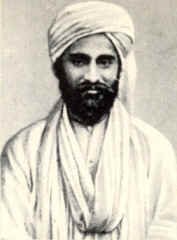 Sundar
Singh was born in northern Indiain 1889. His mother, a deeply religious
woman, nurtured him in the noble traditions of the Sikhs. Sundar often
spoke of his mother with much love and respect because of the good
foundation she laid for his life to come. He was raised in the luxury of
his family's wealth. As a Sikh, Sundar was taught about Hinduism and
came along with his parents to Hindu and Sikh temples.
Sundar
Singh was born in northern Indiain 1889. His mother, a deeply religious
woman, nurtured him in the noble traditions of the Sikhs. Sundar often
spoke of his mother with much love and respect because of the good
foundation she laid for his life to come. He was raised in the luxury of
his family's wealth. As a Sikh, Sundar was taught about Hinduism and
came along with his parents to Hindu and Sikh temples.
Owing to his mother's connections with some women from a British
mission in Rajpur, Sundar was able to enter the school run by the
missionaries. It was there that Sundar was first exposed to the Bible.
With the death of his beloved mother
when he was only fourteen years old, his life had changed dramatically.
The young Sundar grew increasingly despairing and aggressive. Convinced
that what Jesus had taught was completely wrong, he tore the Bible apart
and burned it. He even threw stones at preachers and encouraged others
to do likewise. However hard he tried, he
couldn't find the peace he had been seeking for in his own religion. He had decided to throw himself under the train if God did not reveal to
him the true way of peace. He prayed repeatedly for God's presence.
After three days, he really saw Jesus' figure in the radiance. Jesus Christ was there in the room, shining,
radiating an inexpressible joy and peace and love, looking at him with
compassion and asking, "Why do you persecute me? I died for you
..." [Acts 9:1-5] At that time, Sundar realized that Jesus was not
dead but alive. Sundar fell on his knees before Him and experienced an
astonishing peacefulness which he had never felt before. The vision
disappeared, but peace and joy lingered within him.
Thereafter his life was transformed. In 1905, he was baptized in an English
church in Simla. At that time, he decided to become a sadhu, so that he
could dedicate himself to the Lord Jesus. As a sadhu, he wore a yellow
robe, barefooted and without provisions. From
here on the life of Sundar Singh became most Christ-like. Being
unwilling to denounce his Master in the face of his family's rejection,
Sundar took the saffron robes of the sadhu and began a life of spreading
the simple message of love and peace and rebirth through Jesus. He
carried no money or other possessions, only a New Testament.
After 1913, he was often persecuted but he was also
miraculously delivered by the Lord. In 1914, Sundar preached in Nepal, a
country with a very strong root of Buddhism. In the town of Rasa, he was
sentenced to death by a local Lama on the grounds of spreading a foreign
religion. He was thrown into a dry well the top of which was then
covered and locked from the outside. He was without food and drink,
naked inside the well together with corpses of executed murderers. He
stayed in the horrible well for 2 days until a stranger came and helped
him out of the well. After relocking the well, the stranger left without
saying anything. Not long after that, Sundar was recaptured and taken to
the Lama. The Lama was very surprised since he had always kept the only
key to the well with him. Realizing that Sundar was under the protection
of a very powerful God, they became fearful of him and begged him to
leave them.
In 1918, Sundar visited Madras where thousands of people gathered to
listen to him preach. There Sundar focused his preaching on Jesus
Christ the redeemer. Sundar often used parables in his preachings.
Sadhu Sundar travelled all over India and
Ceylon. Between 1918-1919, he visited Malaysia, Japan and China. Between
1920-1922 he went to Western Europe, Australia and Israel. He preached
in many cities; Jerusalem, Lima, Berlin and Amsterdam among others.
Sundar remained modest despite his fame. His attitude made his father
repent. Sundar never thought of himself. He only desired to follow
Jesus' example: to repay evil with kindness and to win over his enemies
by love. This attitude often caused his enemies to feel ashamed of
themselves.
In 1929, Sundar visited Tibet again and was never seen since. Sundar manifested into his life
the verse written in Mark 8:35 which says, "For whoever wants to
save his own life will lose it; but whoever loses his life for Me and
for the Gospel will save it."
<information from http://sadhusundarsingh.homestead.com/files/story.htm;
photo from http://www.vergeestelijking.nl/mystici/dpdefSadhuSundarSingh.html>